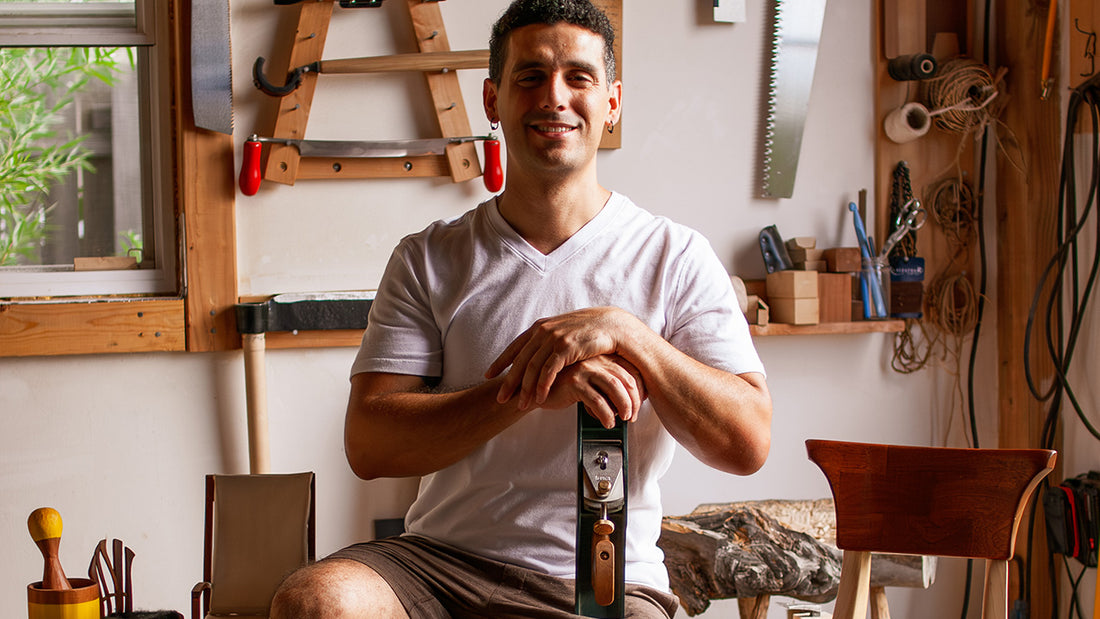From Shoutout Colorado. Click here to view on the publication's website.
We had the good fortune of connecting with Carlos Flores and we’ve shared our conversation below.
Hi Carlos, where are you from? We’d love to hear about how your background has played a role in who you are today?
I am from Puerto Rico. While I have lived in the states since I was eight years old, it was in fact the work of unpacking my heritage and trying to heal my connection to my ancestors that led me to woodworking. When you’re born in Borikén (Puerto Rico), you are part of what we call the criollo Puertorriqueño, a result of the complex interplay between our Taíno, African and Spanish ancestors. My DNA test proves what we know culturally also exists in our blood. Armed with that knowledge, I spent a number of years trying to dig into the stories of my people who have been erased, only to discover that it truly was merely scratching the surface. One day, within this struggle, I felt a call I had been feeling for some time, to explore Bomba, our oldest existing folkloric music. Bomba has roots from our whole criollo, with special influence from our African cultures. I grew up studying classical music, and while there is much value in it, it felt wrong that our own music had been devalued, and treated as less worthy of study or respect. Coming from this point of view, there was a deep threshold that had to be crossed—a shift in perspective, and a certain permission I had to give myself, that I’d felt I could never have. The instant I gave myself that permission, a whole world opened up, and I learned and learned about the history of bomba and its various rhythms and traditions, and before I knew it I found I needed to feel it for myself. The first time I played Bomba, I felt my chest open, as if I had breathed for the first time. By now you’re probably wondering what in the world this has to do with woodworking! On the one hand, there was the simple practice of giving myself permission to follow the road put before me by my instincts. And on the other hand, there’s the nature of Bomba itself, which is very fluid and responsive (in our tradition, the dancers dictate how the lead drummer will play their repiques, salient notes that soar over hypnotic rhythms, and so it is very much a responsive conversation), and requires the player to be deeply in tune with their intuition, and plenty of trust. The truth is, woodworking had called me at a very young age, and much like Bomba, I’d felt it was a calling I wasn’t allowed to pursue. But after over a decade of working as a filmmaker and feeling myself increasingly at odds with myself, Bomba was the last step in unlocking my desire to work in this medium, and I find myself once again so grateful for my intuition, and for learning to trust it, and for finding yet another deeper level of breath. This is the reason I named my company Una Raíz. It comes from a fuller sentiment that goes: de sólo una raíz, todo nace (“from only one root, all is born”). It alludes both to the complex beauty that makes up my culture and informs everything I do, as well as to the path that led me here, in all its winding and seemingly unrelated ways. Also to this end, my logo is based on the Taíno symbol for the coquí, a tree frog endemic to the island of Borikén, whose sweet song fills the night and to me represents the safety of childhood in my homeland. The name and logo together serve me as a reminder that I do this work, in the way I am called to do it, for my ancestors. Too often my people have been abused, stomped on, stolen from, dehumanized, and erased. The Taíno had a tradition, the aréyto, a song and dance performed periodically, in which the story of their people was told, and every time they would add something new, thereby weaving an oral, living history. I have no intention of reproduction style work, as I feel it would be an insult to create without an earned understanding of the meaning behind the work. And yet, Taíno craftspeople’s fluid approach to movement and meaning and three-dimensionality all feed my style in design, and so, in my own way, I hope that I can be merely another person in the continuation of the aréyto, honoring my ancestors, and adding my song to our collective stories.

Alright, so let’s move onto what keeps you busy professionally?
One of the many things that I love about woodworking is that what you produce is just as much to do with how you design and problem-solve, as it does with how you approach the physical act of crafting. I make fine, one-of-a-kind and bespoke furniture as well as smaller hand carved items for the home such as bowls, bud vases, and kitchen tools. And while I am passionate about these items and their function, I am equally passionate about how I make them. It is vital to me and my philosophy in this craft that I keep hand-and-body-powered tools at the center of everything I make. I am no purist—when the ambitions of my fluid designs require more modern techniques such as brick lay or bent lamination, I will not hesitate to brush off my table saw and get to work. But when it comes to cutting stock to size, planing it flat, cutting joinery, or carving out a seat or a bowl, I must return to my heart in the handsaw, the hand plane, the chisel, the axe and the adze. Why? On one hand, there is the matter of pride, of the freedom I see in mastering this ancient medium without being beholden to requiring more and more gadgets with promises of ease and speed. I desire to release reliance on false ideas of efficiency that harm my soul and our planet. Hand tools leave a substantially smaller carbon footprint, allow me to use what I consider a sacred material with as little waste as possible, and often result in stronger, longer-lasting work because everything has to be done with respect to the nature of wood grain. And on the other hand, working in this way brings me peace. Hand-powered work is a quiet practice that allows for conversation with the material and with the self, and requires a deep level of focus and discipline. These qualities imbue themselves into the object for its new owner to benefit from them. Nothing brings me greater joy than to hear a customer remark on the energy they feel in a piece, or when they say that the more they interact with it, the more they see or get from it. This work is not easy. But if, through my objects, I can bring to someone else the tranquility and self reflection that I get from a sharp plane whistling through a board, then I have completed my mission.
When it comes to design, I pride myself in always creating from the heart, and never as a reproduction of someone else’s intention. I draw inspiration from many cultures—from my own Indigenous-African-Spanish background as well as Japanese, Thai, and certain European design philosophies, with great respect for the many masters of this craft around the world, but always with the intention of being as true as possible to my authentic self and to my intuition. In the predominantly Eurocentric perspective that permeates this field (where we live, anyhow), I think you’ll find that my work stands out. And that it does so while retaining a high level of finish, solid long-lasting joinery, as well as comfort and utility. For instance, the chair is quite possibly my favorite thing to make. In its design, the human body is at the core, which I don’t take lightly, and presents many exciting challenges. Most people may, unfortunately, never know how it feels to sit in a chair that is truly ergonomic and is tailored to their unique needs and proportions, and so I find great honor in serving this privilege. From this purpose, I build out my fluid sense of style with solid mortise-and-tenon joinery, which is no simple feat and involves many complex angles. Taíno craftspeople were masters of three-dimensional sculpting that would transform drastically but seamlessly and you turned the piece around in your hand. I’d never dare to claim I have the same level of mastery, but I do draw inspiration from this concept. In fact, my chairs (and many of my designs) can be very difficult to capture in a photograph, as every angle will provide a different note, a new texture, an accompanying rhythm, a new perspective. I think of it as music in physical form, and I find that it’s such a refreshing thing to have in one’s home. One of my chairs, or tables, or bowls is not just another static object to be acquired, but a living, breathing member of the family.

Any places to eat or things to do that you can share with our readers? If they have a friend visiting town, what are some spots they could take them to?
Ah! As someone who spends a lot of time in solitude, this is a bit of a tough question for me. First that come to mind are some of the many incredible natural experiences that we are fortunate to have at our fingertips, from the Rocky Mountain Arsenal Wildlife Refuge right here in Denver, to Bear Creek in Idledale, to Maxwell Falls in Conifer, and to my favorite quick-hike spot in Golden that I will not name, as I highly prize the quiet tranquility that I find there. I would also have to take them to Cheesman park, to Whittier Café, and the Denver Museum of Nature & Science.

The Shoutout series is all about recognizing that our success and where we are in life is at least somewhat thanks to the efforts, support, mentorship, love and encouragement of others. So is there someone that you want to dedicate your shoutout to?
Absolutely! I would first like to thank my partner Connie, for supporting me in following my heart with this craft, even when it meant flipping our lives upside down. I would like to thank my parents for all the sacrifices they made for my sister and me, and more specifically my father José for teaching me music, and my mother Dharma for teaching me the magic of creating art and objects with my hands. A special shoutout to all the fantastic instructors at the Red Rocks School of Fine Woodworking, without whose teachings I would be nowhere near where I am today in my work. Finally, thank you to all the makers out there still making, despite the challenges of a mega-industrialized world, and who continue to generously share their methods, techniques, perspectives, and philosophies with all of those out here listening.
Website: unaraiz.com
Instagram: instagram.com/unaraizwoodworks
Facebook: facebook.com/unaraizwoodworks/
Youtube: youtube.com/@UnaRaizWoodworks







